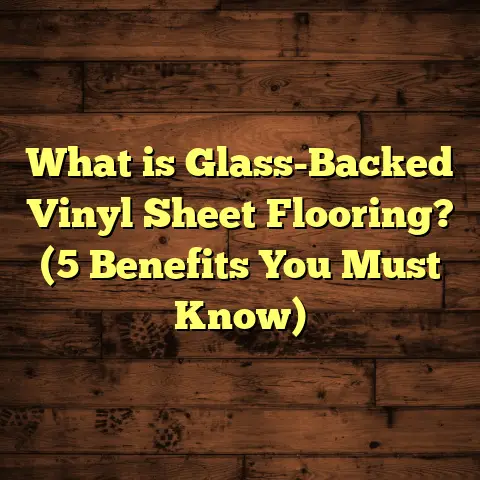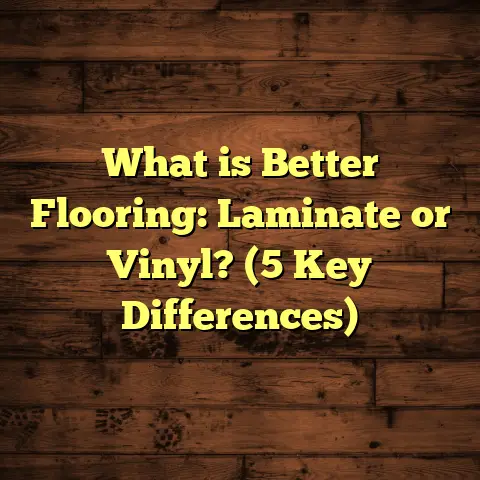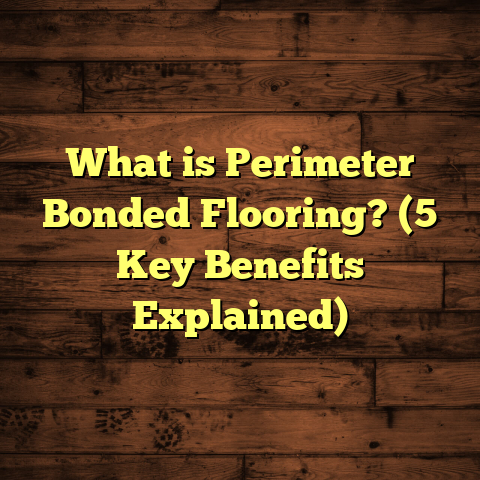What is Vivero Flooring Made Of? (5 Key Components Explained)
I still remember stepping into a home where the floor immediately felt different beneath my feet. It wasn’t just the look but the whole vibe — warm, sturdy, yet somehow soft. That floor was covered with Vivero flooring, and I was hooked. I wanted to know exactly what makes this flooring so special. So, let me walk you through what Vivero flooring is made of, by breaking down its five key components in detail.
What is Vivero Flooring Made Of?
At its core, Vivero flooring is a type of luxury vinyl flooring designed to bring together beauty, durability, and practicality. It’s not just one material slapped on top of another; it’s a carefully engineered product with multiple layers, each serving a purpose.
When you break it down, here’s what you find:
- The wear layer that protects your floor from daily damage.
- The print film layer that gives you realistic wood or stone visuals.
- The core layer that provides strength and stability.
- The backing layer that supports and protects against moisture.
- The optional adhesive layer used in some installation methods.
Each of these layers plays a distinct role in how the floor performs over time. Let’s explore each one in detail.
1. Wear Layer: Your Floor’s Shield
The wear layer is the topmost protective shield. Imagine it as the armor your floor wears every day against scratches, stains, dents, and fading. Without a strong wear layer, even the most beautiful floor can look worn out in no time.
Vivero floors typically feature a wear layer thickness between 20 to 30 mils. That’s thicker than many budget vinyl options and comparable to some high-end luxury vinyl planks (LVP) on the market.
In my experience installing floors across different settings — from quiet homes to busy commercial spaces — the thickness and quality of the wear layer are crucial. For example, in a bustling restaurant I worked on last year, the Vivero floor with a 30-mil wear layer showed almost no signs of wear after six months of heavy foot traffic and occasional spills. Compare that to a cheaper vinyl product that would have shown scratches or scuffs within weeks.
The wear layer is also treated with UV protection to prevent discoloration from sunlight. So if you’re installing near large windows or in sunrooms, this feature matters.
This protective topcoat is what keeps your floor looking fresh for years without needing refinishing or replacement.
2. Print Film Layer: Realism You Can See and Feel
If you’re like me, looks matter — especially when it comes to flooring. The print film layer is where the visual magic happens in Vivero flooring. This is a high-resolution photographic layer printed onto the vinyl to mimic real wood grain patterns, stone textures, or other natural surfaces.
What sets Vivero apart from standard vinyl floors is the level of detail and embossing applied to this print film. The textures are embossed or even registered embossing where the texture aligns perfectly with the print pattern.
I’ve installed floors where guests were convinced they were stepping on real hardwood or slate because of how authentic it looked and felt.
This layer is also sealed beneath the wear layer, so dirt or scratches don’t wear down the image quality.
From a technical standpoint, the print film is created using advanced digital printing techniques which allow for incredible color accuracy and pattern variation — unlike laminate that tends to repeat patterns more noticeably.
3. Core Layer: The Strong Backbone
One of the biggest differences I’ve noticed when comparing Vivero to other luxury vinyl products is its rigid core construction. This core layer is generally composed of limestone composite (LPC) or wood plastic composite (WPC), materials engineered for strength and stability.
Why does this matter? Let me tell you from experience.
Traditional flexible vinyl planks often feel hollow or “spongy” underfoot. That’s because they lack a solid core. But Vivero’s rigid core means each plank has a firm feel closer to hardwood or tile. This makes walking on it more comfortable and less noisy.
On a job where radiant heat was installed beneath the floor, Vivero’s rigid core handled temperature changes without warping — something I rarely see with cheaper vinyls.
Its core also contributes to dimensional stability — meaning fewer gaps or lifting over time due to humidity or temperature fluctuations.
Data shows that floors with rigid cores can last up to 20 years or more with proper care compared to about 10-15 years for flexible vinyl floors.
4. Backing Layer: Moisture Barrier and Support
The backing layer is often overlooked but vital for long-term performance. It supports the whole plank from underneath and prevents moisture from seeping up from below — especially important for installation over concrete slabs or basements.
Vivero usually comes with an attached underlayment backing that offers sound insulation and comfort underfoot while acting as a moisture barrier.
In one basement renovation job, this backing saved the floor from potential moisture damage caused by slight water seepage through the concrete slab.
I always recommend floors with pre-attached backing for easier installation because it eliminates the need to add separate underlayments which can increase labor time and cost.
5. Adhesive Layer: Optional Glue-Down Method
Most Vivero floors use a click-lock system for floating installation — ideal for DIYers or quick installations. However, in some cases such as commercial settings or rooms with heavy moisture, a glue-down installation method may be preferred.
In those cases, an adhesive layer is applied beneath the planks during installation to fix them permanently to the subfloor.
I’ve done projects where glue-down was necessary due to high humidity or rolling loads (think heavy office chairs). In those scenarios, combining adhesive installation with Vivero’s layers gives extra durability and water resistance.
The adhesive itself isn’t part of the plank but still critical in those specific installations for long-lasting performance.
How Does Vivero Compare to Other Flooring Types?
You might be wondering how Vivero stacks up against hardwood, laminate, traditional vinyl, or other luxury vinyl options. Over my years as a flooring contractor, I’ve installed all these types multiple times — here’s what I’ve learned:
Hardwood vs. Vivero
Hardwood floors have unmatched natural beauty and can be refinished multiple times. But they’re expensive ($8–$15 per sq ft installed), sensitive to moisture, require regular maintenance like polishing and refinishing, and aren’t ideal for wet areas.
Vivero offers similar aesthetics at a lower price point ($4–$7 per sq ft installed), greater moisture resistance, and minimal upkeep. While you can’t refinish vinyl like hardwood, Vivero’s durability means you likely won’t need to replace it for many years.
Laminate vs. Vivero
Laminate is affordable and decent looking but lacks real texture — often feeling hollow or plastic-like underfoot. Laminate also struggles with water damage; spills can cause swelling or warping quickly.
Vivero beats laminate on texture realism thanks to its embossed print film and rigid core feel. Plus, it’s water-resistant making it great for kitchens or basements where laminate would fail.
Traditional Vinyl vs. Luxury Vinyl (Vivero)
Basic vinyl flooring is cheap but tends to be thin with weak wear layers that scratch easily. It often has flat designs without texture making it look less natural.
Vivero’s thicker wear layers, better print quality, embossed textures, and rigid cores give it superior durability and appearance compared to basic vinyl products.
Other Luxury Vinyl Brands vs. Vivero
Not all luxury vinyl planks are created equal. Some brands skimp on wear layer thickness or use less rigid cores which can affect longevity and feel.
I’ve tested several brands side by side in installations and found Vivero consistently offers better stability and surface protection at a competitive price point.
Real-World Case Studies: Seeing Vivero in Action
I want to share some stories from actual projects where I installed Vivero flooring so you get a real sense of how it performs over time:
Case Study 1: A Family Home With Kids & Pets
A client called me after struggling with hardwood floors scratched up badly by their two energetic kids and a large dog. They wanted something durable but still stylish.
We chose Vivero with a 30-mil wear layer and wood-look print film for their living room and kitchen. After two years of daily wear — kids playing with toys dropped on the floor, muddy paws tracked in — the floor still looked pristine.
They loved how easy cleanup was too — just sweeping and occasional damp mopping.
Case Study 2: Commercial Office Space
A local business owner needed new flooring that could handle heavy foot traffic and rolling office chairs without damage.
We installed glue-down Vivero planks with an attached moisture barrier backing over concrete slabs. The rigid core provided enough firmness that chairs rolled smoothly without denting the floor.
The owner reported zero complaints after six months despite dozens of employees working there daily.
Case Study 3: Basement Renovation
Basements are tricky due to moisture risks. A homeowner wanted a stylish floor resistant to humidity but didn’t want cold tile.
We installed floating Vivero flooring with pre-attached backing over a vapor barrier membrane. The rigid core prevented warping despite minor moisture fluctuations below.
After one year, no signs of damage appeared even after seasonal humidity changes.
How I Use FloorTally for Budgeting Flooring Projects
Budgeting flooring projects can be tricky — there are so many variables: material costs, labor rates in your area, waste factors due to cuts or mistakes…
I started using FloorTally some time ago because it simplifies all those calculations into one easy platform. Here’s how it helps me:
- I input exact room dimensions along with a waste factor (usually 7-10%) so clients don’t get surprised by needed extra material.
- It pulls local labor rates automatically so my estimates reflect realistic costs.
- I select product options like wear layer thickness or installation type.
- FloorTally generates an itemized budget I can share instantly with clients.
- It helps me compare costs between different flooring options quickly so homeowners can make informed choices based on both style and budget.
Using this tool saves me hours every week juggling spreadsheets or calling around for quotes — plus clients appreciate transparent pricing upfront.
Maintenance Tips: Keeping Your Vivero Floor Looking Great
One of the best things about Vivero is how low maintenance it is compared to hardwood or laminate floors. Still, here are some tips I always pass along:
- Sweep or vacuum regularly to avoid dirt scratching the surface.
- Use damp mops with gentle cleaners designed for vinyl floors.
- Avoid abrasive scrubbing pads or harsh chemicals.
- Place felt pads under furniture legs to prevent dents.
- Clean spills promptly to avoid staining.
- Avoid waxes or polishes as they can build up on vinyl surfaces.
Following these simple steps will keep your floor looking like new for years.
Answering Your Burning Questions About Vivero Flooring
Is Vivero Flooring Waterproof?
Vivero flooring is highly water-resistant thanks to its rigid core and backing layers but not technically 100% waterproof like some specialized products. It handles spills well but prolonged standing water should be avoided.
Can You Install Vivero Flooring Over Radiant Heat?
Yes! Its rigid core construction makes it compatible with most radiant heating systems without risk of warping.
How Long Does Vivero Flooring Last?
With proper care and normal household use, expect 10-20 years depending on thickness of wear layer and traffic levels.
Is Installation DIY-Friendly?
Yes — floating click-lock systems make DIY installation possible for those comfortable with basic tools though glue-down methods may require pros.
Wrapping Up My Take on What Makes Vivero Flooring Special
To circle back — understanding what goes into each layer of Vivero flooring helps explain why it balances beauty, durability, comfort, and affordability so well. From my hands-on projects and research:
- The thick wear layer guards against everyday abuse.
- The print film delivers realistic aesthetic appeal.
- The rigid core offers solid footing and stability.
- The backing provides moisture protection and sound reduction.
- Optional adhesive installation adapts to special needs.
If you want floors that look great today and keep looking great years down the road without hassle or huge expense — Vivero deserves serious consideration.
Got more questions? Just ask — happy to share everything I’ve learned from working directly with these floors!





